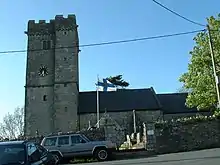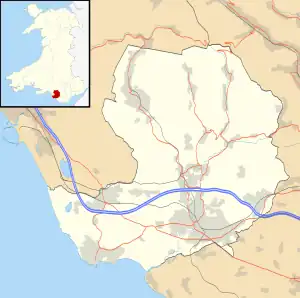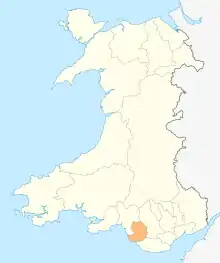St David's Church, Laleston
St David's Church, Laleston is a Grade I listed church in Laleston, Bridgend County Borough, southern Wales. It is listed Grade 1 as a medieval church with its fabric, including timber roofs, mainly intact, and having group value with the churchyard cross and Cliff Cottage.[1]
| St David's Laleston | |
|---|---|
 St. David's Church | |
 St David's Laleston Location in Bridgend County Borough | |
| 51.5065°N 3.6218°W | |
| OS grid reference | SS 875 798 |
| Location | Laleston, Bridgend |
| Country | Wales, United Kingdom |
| Denomination | Church in Wales |
| History | |
| Founded | 13th century |
| Dedication | Saint David |
| Architecture | |
| Heritage designation | Grade I |
| Architectural type | Church |
| Style | Medieval |
History
In 1180, William, Earl of Gloucester is recorded as having granted land in the area to William Lageles, from whom the village is thought to have got its name. The current church was built later, to replace the nearby church of St Cewydd,[1][2] the site of which is known.[3] The nave and chancel are believed to date to the late 13th and 14th centuries, and the southern porch and tower to the later medieval period.
During the 16th century the church and the manor of Laleston belonged to Margam Abbey, and in 1522, the parishioners were given a lease on the tithe barn.[4] At the Dissolution, Sir Rice Mansel purchased the manor.[5]
Those who officiated as parish priests or curates over the years included John Evans (died 1847) who later turned to Methodism.[6]
Sir Stephen Glynne, 9th Baronet, visited the church in 1847, and left a written account of the architecture.[7]
Architecture
The church is built on a standard plan, with a west tower, nave and lower chancel. It has, probably incorrectly, been attributed to a 12th-century mason called "Lalys".[8]
The tower interior is in the Perpendicular Gothic style. The church underwent restoration by John Prichard in 1871, and the stained glass windows, probably by Clayton and Bell, are from that decade.[9]
Interior
The interior is limewashed, and features numerous engravings on the walls, dated to the 17th and 18th centuries. The chancel stalls, of oak, and the desk and pulpit date to 1958. William Clarke of Llandaff was hired for wood carvings in the sanctuary; he added the reredos in 1908. St David's Church became a Grade I listed building on 26 July 1963.[9]
Memorials
Several graves of the Ben(n)et family of Laleston House (located close to the church),[10] a family notable locally in the 17th and 18th centuries, are to be found in the church.[11] In 1762, Thomas Bennet left a legacy of £52 10s for poor relief.[10]
References
- "Church of St David". Laleston Community Council. Retrieved 13 March 2020.
- Henry John Randall (1961). The Vale of Glamorgan: Studies in Landscape and History. R. H. Johns. p. 88.
- Sabine Baring-Gould; John Fisher; Honourable Society of Cymmrodorion (1908). The lives of the British saints: the saints of Wales and Cornwall and such Irish saints as have dedications in Britain. For the honourable Society of Cymmrodorion, by C. J. Clark. p. 116.
- Glanmor Williams (1976). The Welsh Church from Conquest to Reformation. University of Wales Press. p. 353. ISBN 978-0-7083-0084-8.
- Royal Commission on the Ancient and Historical Monuments in Wales (1976). An Inventory of the Ancient Monuments in Glamorgan. RCAHMW. p. 187. ISBN 978-0-11-700754-3.
- Gomer Morgan Roberts. "Evans, John (1779-1847), cleric, afterwards Calvinistic Methodist minister". Dictionary of Welsh Biography. National Library of Wales. Retrieved 13 March 2020.
- Geoffrey R. Orrin (2004). Church Building and Restoration in Victorian Glamorgan: An Architectural and Documentary Study. University of Wales Press. p. 67. ISBN 978-0-7083-1837-9.
- John Hooper Harvey (1987). English mediaeval architects: a biographical dictionary down to 1550 : including master masons, carpenters, carvers, building contractors and others responsible for design. Sutton. p. 170. ISBN 978-0-86299-452-5.
- "Church of St David, Laleston". British Listed Buildings. Retrieved 30 April 2016.
- Samuel Lewis (1840). A Topographical Dictionary of Wales. S. Lewis. p. 9.
- John Burke (1835). A Genealogical and Heraldic History of the Commoners of Great Britain and Ireland Enjoying Territorial Possessions Or High Official Rank, But Uninvested with Heritable Honours. H. Colburn. pp. 23–5.
Bibliography
- Newman, John (1995). Glamorgan. London: Penguin Group. ISBN 0140710566.
